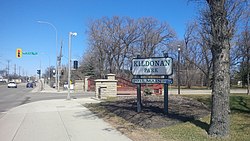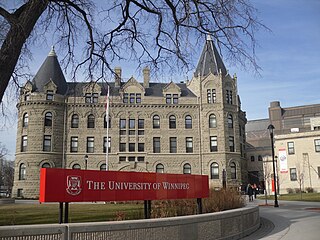
Winnipeg is the capital and largest city of the province of Manitoba in Canada. It is centred on the confluence of the Red and Assiniboine rivers, near the longitudinal centre of North America. As of 2021, Winnipeg had a city population of 749,607 and a metropolitan population of 834,678, making it the sixth-largest city, and eighth-largest metropolitan area in Canada.
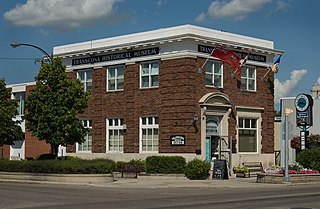
Transcona is a ward and suburb of Winnipeg, Manitoba, located about 10 kilometres (6.2 mi) east of the downtown area.
George Edward Olive was a politician in Manitoba, Canada. He served in the Legislative Assembly of Manitoba from 1945 to 1953, as a member of the social-democratic Cooperative Commonwealth Federation (CCF).
Route 17, also known as Chief Peguis Trail, or CPT, is a major highway in Winnipeg, Manitoba, Canada. The highway connects Routes 52 and 20.
St. Vital is a ward and neighbourhood of Winnipeg, Manitoba, Canada.

The amalgamation of Winnipeg, Manitoba, was the municipal incorporation of the old City of Winnipeg, 11 surrounding municipalities, and the Metropolitan Corporation of Greater Winnipeg (Metro) into a one Unified City of Winnipeg, or Unicity.
North Kildonan is a city ward in northern Winnipeg, and a former municipality in Manitoba, Canada. Its population was of 2016 was 44,664.
Metropolitan Corporation of Greater Winnipeg was a governing body that served as part of the leadership for the metropolitan area of Winnipeg. It was established by Premier Douglas Campbell after he was given a commission to do so by the Greater Winnipeg Investigating Commission. It was dissolved when its component municipalities were amalgamated into one "unicity" in 1972. Winnipeg is a city in Manitoba, Canada.

Assiniboine Park is a park in Winnipeg, Manitoba, Canada, located along the Assiniboine River.

The Forks is a historic site, meeting place, and green space in downtown Winnipeg located at the confluence of the Red River and the Assiniboine River.

Rainbow Stage is the leading not-for-profit musical theatre company in Canada, as well as the country's largest and longest-running outdoor theatre, located in Kildonan Park in north Winnipeg, Manitoba. The covered amphitheatre seats up to 2,600 people and operates from May to September.
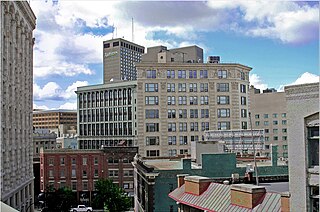
The Exchange District is a National Historic Site of Canada in the downtown area of Winnipeg, Manitoba, Canada. Just one block north of Portage and Main, the Exchange District comprises twenty city blocks and approximately 150 heritage buildings, and it is known for its intact early 20th century collection of warehouses, financial institutions, and early terracotta-clad skyscrapers.
Manitoba Centennial Centre is an arts and cultural district that covers a 34-acre area in the east Exchange District of the Point Douglas area in Winnipeg, Manitoba, linking several of Manitoba's important arts and cultural facilities. It includes the Centennial Concert Hall, the Manitoba Museum, Planetarium and Science Gallery, the Royal Manitoba Theatre Centre, Manitoba Production Centre, Artspace, three nearby surface parking lots, and the building at 11 Lily Street.
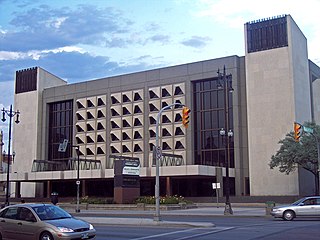
Centennial Concert Hall is a 2305-seat performing arts centre located at 555 Main Street in downtown Winnipeg, Manitoba, Canada, as part of the Manitoba Centennial Centre. The concert hall opened on March 25, 1968.
Wildwood Park is a suburban, planned community in Winnipeg that has a central green space and no front roads, with communal walkways, playgrounds, and parks.
Route 42 is a major arterial road located in Winnipeg, Manitoba.

The Pan Am Pool is an indoor swimming facility in Winnipeg, Manitoba, Canada built for the 1967 Pan American Games. It is located in southwest Winnipeg and consists of three pools: two are used for competitive swimming and one is a children's "kiddie pool".
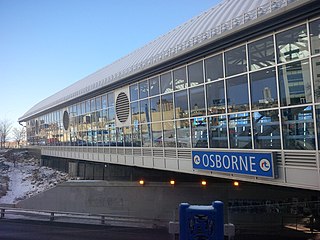
Winnipeg RT is a bus rapid transit system of Winnipeg Transit in Winnipeg, Manitoba, Canada, currently consisting of the Southwest Transitway. Future expansions are in the planning stages, consisting of an Eastern Corridor connecting downtown to Transcona and a West-North Corridor connecting St. James with Downtown and West Kildonan.

Isadore "Issie" Coop (1926–2003) was a Canadian architect and a Fellow of the Royal Architectural Institute of Canada, with a reputation for highly functional, cost-effective architecture. A student of the famed American-German architect Ludwig Mies van der Rohe, Coop brought the Miesian style to Winnipeg, and changed the face of Winnipeg architecture, according to one writer.
Ernest John Smith was a Canadian architect.
